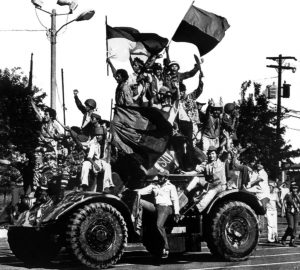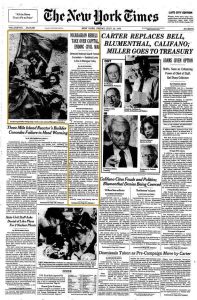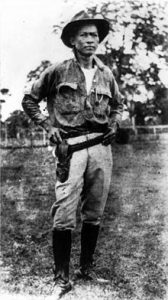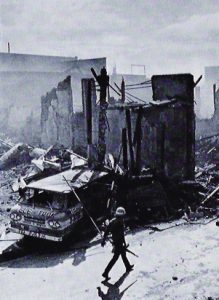
July 19th, 1979. Victorious Sandinistas enter Managua.
Somoza may be a son of bitch, but he is our son of a bitch. – Franklin D. Roosevelt
As I began researching the events of July 19th, 1979 I thought back to the final research paper I wrote for AP US History in high school entitled “United States’ Intervention in Nicaragua.” With a little digging through old computer files I was able to pull it up. The roots of the Sandinista Revolution trace back, unsurprisingly, to 20th century American imperialism. Below I have excerpted a paragraph of my high school essay to contextualize the rise of the Sandinistas.
The legacy of American occupation and intervention profoundly influenced modern Nicaragua politically, economically, and socially. When the United States selected Panama over Nicaragua as the recipient for an isthmian canal and the resulting American capital in 1903, the relationship between the countries deteriorated. In 1909, the United States supported a successful coup to overthrow Nicaraguan president José Santos Zelaya because of his efforts to attract non-American capital to finance a competing canal. The flagrant promotion of the economic self-interest provoked anti-American sentiment and insurgencies against the unpopular new government. Consequently, in 1912 American troops invaded to restore order and reassert Nicaraguan dependency. The occupation continued intermittently until 1933. Amidst renewed violence, in 1927 American diplomat Henry Stimson negotiated a widely accepted peace settlement. However, the nationalist Augusto Sandino rejected the premise of continued American intervention. He recruited a peasant army and led a five-year guerilla campaign against U.S. Marines. Concurrently, in 1933, at the height of the Great Depression, maintaining a U.S. presence in Nicaragua became economically unfeasible. To uphold political stability once American forces were removed, the United States trained a local National Guard as a “non-political constabulary” and placed Anastasio Somoza García as its leader. However, the new commander abused his position, assassinating Sandino after the negotiation of a truce and seizing control of the government.
A free country or death. – Sandinista motto
When in 1961 a revolutionary group committed to socialism and the overthrow of the Somoza regime formed, the martyred Augusto Sandino was thus the natural choice for a symbol. The new Sandinista National Liberation Front (FSLN) called upon the long history of Nicaraguan nationalism and resistance to American intervention. The burgeoning Sandinistas did not gain a significant following until the 1972 earthquake in Managua shook things up. The widespread devastation and corruption that followed led to increased unrest and resentment against the Somoza government. Throughout the 1970s the Sandinistas gained momentum, especially after the Carter administration cut off aid in 1977 to Somoza because of human rights’ abuses. Between 1978-1979 the Sandinistas waged a fierce guerrilla war against the Somoza government. Finally, on July 17th 1979 Somoza resigned and fled to Miami, leaving the country in the hands of a weak interim government.
It is now a free country without death. – Sandinista rebel
 On July 19, 1979 the New York Times reported, “The Sandinist takeover of Managua came suddenly and almost peacefully in the wake of General Somoza’s resignation and flight into exile in Miami early Tuesday.” With morale destroyed after Somoza’s escape, the National Guard surrounded to Sandinista forces and on July 19th the rebels took over Managua. The New York Times described that “Excited crowds lined the streets of the capital as truckloads of young rebels, many of them dressed in olive green uniforms and carrying automatic rifles, drove around the city, waving the redand‐black Sandinist flag and firing shots into the air.” Civilians and guerrilla fighters flooded into the Plaza de la República—the center of Managua, since renamed Plaza de la Revolución—to celebrate. At long last the fighting was done and the Somoza regime gone forever.
On July 19, 1979 the New York Times reported, “The Sandinist takeover of Managua came suddenly and almost peacefully in the wake of General Somoza’s resignation and flight into exile in Miami early Tuesday.” With morale destroyed after Somoza’s escape, the National Guard surrounded to Sandinista forces and on July 19th the rebels took over Managua. The New York Times described that “Excited crowds lined the streets of the capital as truckloads of young rebels, many of them dressed in olive green uniforms and carrying automatic rifles, drove around the city, waving the redand‐black Sandinist flag and firing shots into the air.” Civilians and guerrilla fighters flooded into the Plaza de la República—the center of Managua, since renamed Plaza de la Revolución—to celebrate. At long last the fighting was done and the Somoza regime gone forever.
In 1980 the five-person junta—including Daniel Ortega—governing Nicaragua proclaimed July 19th a public holiday to celebrate liberation from Somoza and the victory of the Sandinista Revolution.
Below is a collection of footage from Nicaragua on July 19, 1979.


